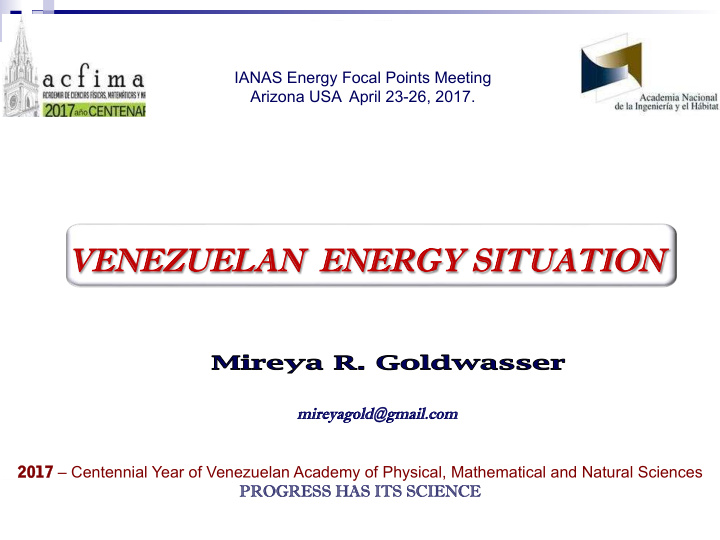



IANAS Energy Focal Points Meeting � Arizona USA April 23-26, 2017. � VENEZUE ZUELAN AN ENERGY SI RGY SITUATI TUATION ON mire mireya yagold old@g @gma mail. il.com om 2017 – Centennial Year of Venezuelan Academy of Physical, Mathematical and Natural Sciences 2017 PROGRESS HAS I PROGRE SS HAS ITS SCI TS SCIENCE CE
� Est stima imated p possib ossible le e energ rgy ( y (2015) Millions � % � Millions % � TPE � of TPE � Oil 1 � 41.065 � 87.6 � Mini Hydraulics � 7 � 1.6 � Bio Energy � 17 � 3.8 � Gas 1 � 4440 � 9.5 � Coal 1 � 360 � 0.7 � Solar � 228 � 50.6 � Wind � 70 � 15.6 � Renewable 2 � 450 � 1.0 � Geothermal � 8 � 1.8 � Nuclear 3 � 560 � 1.2 � Maremotriz � 26 � 5.8 � Total � 100.0 � 46.875 � Hydraulics � 94 � 20.8 � TPE = 7.33 Equivalent Oil Barrels � Total � 450 � 100.0 � Estimated Energy consumption 2015 = 115 IPN + 220 MI = 335 kTPED � Only the renewable can cover the consumption � Source: � (1) BP Report (2014) � (2) “Energías Renovables: potencial energético de recursos aprovechables”. División de Alternativas Energéticas, MEM (2001) MARTÍNEZ, A. � (3) Venezuela en el Juego Nuclear � (http://plumacandente.blogspot.com/2009/10/venezuela-en-el-juego-nuclear.html) � Infograph: N. Hernández �
� � Tot Total N l Natura ral Ga l Gas Re s Rese serve rves � � Reserves Type � tcf � Proven Developed 39.4 Proven no-developed 162.0 Total Proven Reserves 201.4 Probable 30.5 Possible 29.6 Total Reserves 261.5 Offshore expectatives 147.0 On earth expectatives 53.0 Total Expectatives 200.0 Total Natural Gas Reserves 461.5 The country has the necessary reserves of natural gas to supply the thermoelectric plants at present and in the future, but one thing will be to produce the natural gas and another to make it available for consumption by the thermoelectric plants. � Source: PDVSA Report 2015 and Others and DJGC own calculations �
� � � � � � � � � � � CURRE CURRENT HYDROE T HYDROELECTRI CTRIC C GE GENERATI RATION ON Venezuela has a great hydroelectric power, even underutilized (Only 31) � Hydropower is an element of sustainable development. It allows: � § reduction of CO 2 emissions. � § integration of renewable energies. � § saving of fuels of fossil origin and their availability for export. � § non-consumptive use of water � The installe The installed capacity amounts to about 24,000 MW (2014 http://www.corpoelec.gob.ve/generaci%C3%B3n � � Hydroelectricity accounts for 49% of installed capacity � Hydroelectricity accounts for 65.3% of electricity generation (2014) � http://www.corpoelec.gob.ve/generaci%C3%B3n � Hydroelectric power generated = 82,3TWh (2014) � (144700 BEP / day) (1BEP = 1586.3 KWh) � BP Statistical Review of World Energy June 2015 � CO 2 emissions Savings = 94.6x 106 Ton �
El I l Isiro Win siro Wind Pow Power Pla r Plant VELOCIDAD DE VIENTO H=50m % ANUAL POR RANGO 55 60 40 25 % 11 20 8 0 0 0 0 - 2 m/s 3 - 6 m/s 7 - 10 11 - 14 15 - 18 m/s 19 - 25 m/s m/s m/s RANGO DE VELOCIDAD ING. JESUS AUGUSTO GOMEZ
� � � Ge Genera ral Re l Rema marks rks Venezuela before an oil country is an energy country � The country, has sufficient energy resources with the aggravating factor that 97.8% are fossil fuels, the most questioned in global energy future schemes. However, the potential of environmentally friendly energy resources can easily cover energy needs beyond the second half of this century. � The country's energy strategy is complex because it must assume responsibility for the safe, reliable and environmentally satisfactory supply of all its citizens and the production of HC to be placed on the international market in order to obtain the economic resources required for its development. � In the prospect shown on energy consumption in Venezuela in 2040, 43% is aimed at generating electricity, which is in line with the world trend of an electrified world. 70% of the generation comes from clean energies � On wind and solar power, Venezuela lags behind not only with respect to developed countries, but among Latin American countries. Even though the Venezuelan State has intended the development of alternative energies, this has not been sustained over time. � Venezuela, requires comprehensive energy planning that originates public policies that guarantee sustainable energy security. �
Recommend
More recommend